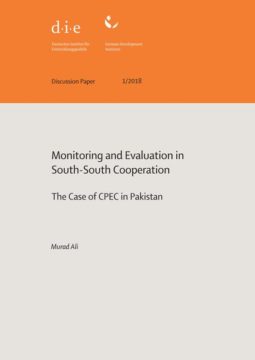Pakistan is one of the key countries in China’s Belt and Road Initiative (BRI) where the latter is implementing a multibillion-dollar, multiyear investment plan known as the China-Pakistan Economic Corridor (CPEC). A collection of projects aimed at developing energy, industry and communication infrastructure, costing over USD 46 billion, CPEC is expected to contribute significantly to socio-economic development and poverty reduction in Pakistan. The main research question is, while implementing development projects in Pakistan, to what extent China adheres to its avowed principles of international development cooperation comprising features such as mutual respect, non-conditionality, equality, building local capacity and addressing actual needs of partner countries. Based mainly on the analysis of primary data collected during fieldwork in Pakistan, this research explores the extent to which the official narrative guides and influences the actual practice of China’s development cooperation on the ground. Although still evolving, the BRI and its constituent the CPEC, which is an investment-grant-loan model of financing in Pakistan, is an example of South-South Cooperation (SSC): the form of international development cooperation whereby “two or more developing countries pursue their individual or collective development through cooperative exchange of knowledge, skills, resources and technical expertise” (UNDP, 2007, p. 1). For the analysis of CPEC-related Chinese investment in Pakistan, this study uses an analytical framework developed by researchers from the South Africa chapter of the Network of Southern Think Tanks (NeST), a group of key research institutions from various developing countries dedicated to generating standardised, systematic and clearly comparable knowledge on SSC (Besharati & Rawhani, 2016; Besharati, Rawhani, & Rios, 2017). Established in 2015, and then refined and finalised in 2017 after a number of expert group meetings and field-based SSC case studies, the framework operationalises various conceptual issues related to the quality and development effectiveness of SSC. The framework, which is discussed later in some detail, comprises five dimensions and a set of 20 indicators. The overall framework and associated dimensions and indicators not only offer valuable parameters to assess the quality and effectiveness of SSC, but these are also closely related to the key principles and features of China’s foreign aid policy. The five key elements of the analytical framework are inclusive national ownership, horizontality, self-reliance and sustainability, accountability and transparency and development efficiency. Within this framework and associated parameters, this research examines the China-Pakistan development partnership under CPEC and explores the extent to which SSC principles are practiced. By systematically examining SSC in the form of Chinese investment and development cooperation projects in Pakistan, this study contributes to the limited body of academic literature on Chinese development cooperation with its key South Asian ally.
- Veröffentlicht am Donnerstag 14. November 2024 von Deutsches Institut f. Entwicklungspolitik
- ISBN: 9783960210580
- 42 Seiten
- Genre: Gesellschaft, Politik, Sachbücher, Wirtschaft
